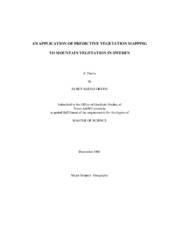| dc.contributor.advisor | Cairns, David | |
| dc.creator | Green, Janet Alexis | |
| dc.date.accessioned | 2006-04-12T16:02:17Z | |
| dc.date.available | 2006-04-12T16:02:17Z | |
| dc.date.created | 2005-12 | |
| dc.date.issued | 2006-04-12 | |
| dc.identifier.uri | https://hdl.handle.net/1969.1/3089 | |
| dc.description.abstract | Predictive vegetation mapping was employed to predict the distribution of vegetation
communities and physiognomies in the portion of the Scandinavian mountains in
Sweden. This was done to address three main research questions: (1) what
environmental variables are important in structuring vegetation patterns in the study
area? (2) how well does a classification tree predict the composition of mountain
vegetation in the study area using the chosen environmental variables for the study? and
(3) are vegetation patterns better predicted at higher levels of physiognomic
aggregation? Using GIS, a spatial dataset was first developed consisting of sampled
points across the full geographic range of the study area. The sample contained existing
vegetation community data as the dependent variable and various environmental data as
the independent variables thought to control or correlate with vegetation distributions.
The environmental data were either obtained from existing digital datasets or derived
from Digital Elevation Models (DEMs). Utilizing classification tree methodology, three
model frameworks were developed in which vegetation was increasingly aggregated into
higher levels of physiognomic organization. The models were then pruned, and
accuracy statistics were obtained. Results indicated that accuracy improved with increasing aggregation of the dependent variable. The three model frameworks were
then applied to the Abisko portion of the study area in northwestern Sweden to produce
predictive maps which were compared to the current vegetation distribution.
Compositional patterns were critically analyzed in order to: (1) assess the ability of the
models to correctly classify general vegetation patterns at the three levels of
physiognomic classification, (2) address the extent to which three specific ecological
relationships thought to control vegetation distribution in this area were manifested by
the model, and (3) speculate as to possible sources of error and factors affecting
accuracy of the models. | en |
| dc.format.extent | 2706353 bytes | en |
| dc.format.medium | electronic | en |
| dc.format.mimetype | application/pdf | |
| dc.language.iso | en_US | |
| dc.publisher | Texas A&M University | |
| dc.subject | Predictive vegetation mapping | en |
| dc.title | An application of predictive vegetation mapping to mountain vegetation in Sweden | en |
| dc.type | Book | en |
| dc.type | Thesis | en |
| thesis.degree.department | Geography | en |
| thesis.degree.discipline | Geography | en |
| thesis.degree.grantor | Texas A&M University | en |
| thesis.degree.name | Master of Science | en |
| thesis.degree.level | Masters | en |
| dc.contributor.committeeMember | Lafon, Charles W. | |
| dc.contributor.committeeMember | Tjoelker, Mark | |
| dc.type.genre | Electronic Thesis | en |
| dc.type.material | text | en |
| dc.format.digitalOrigin | born digital | en |


